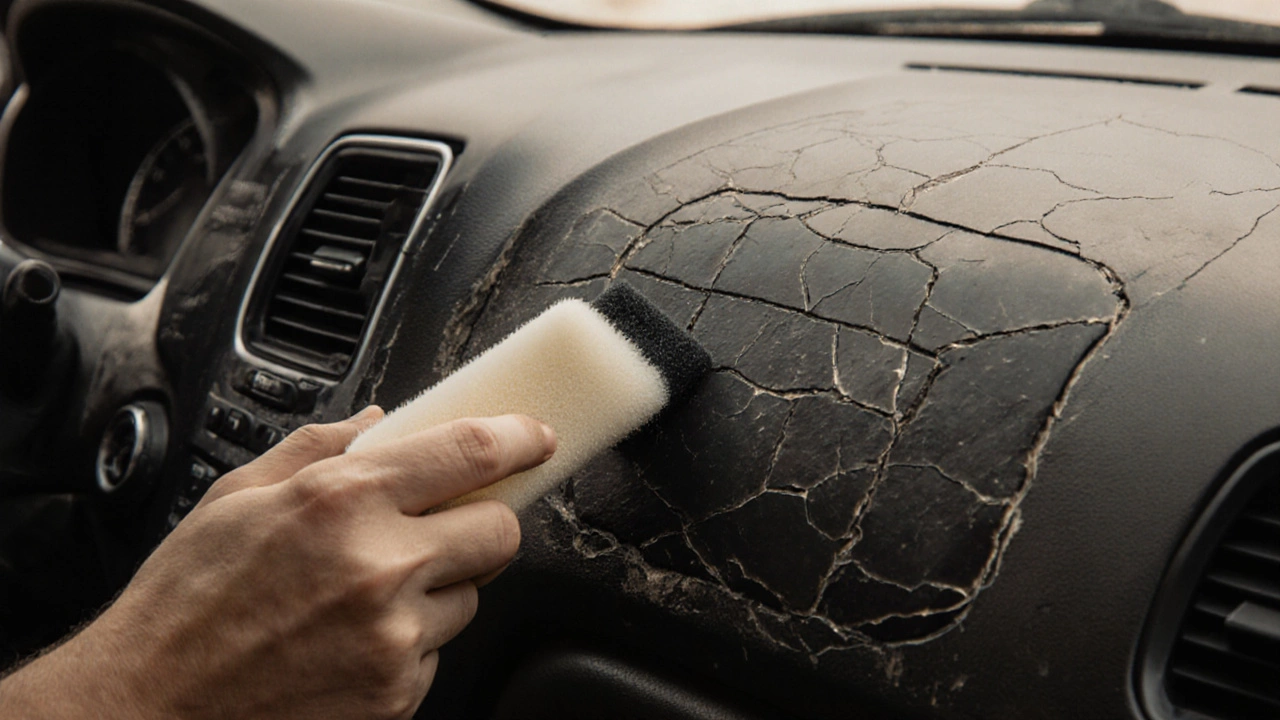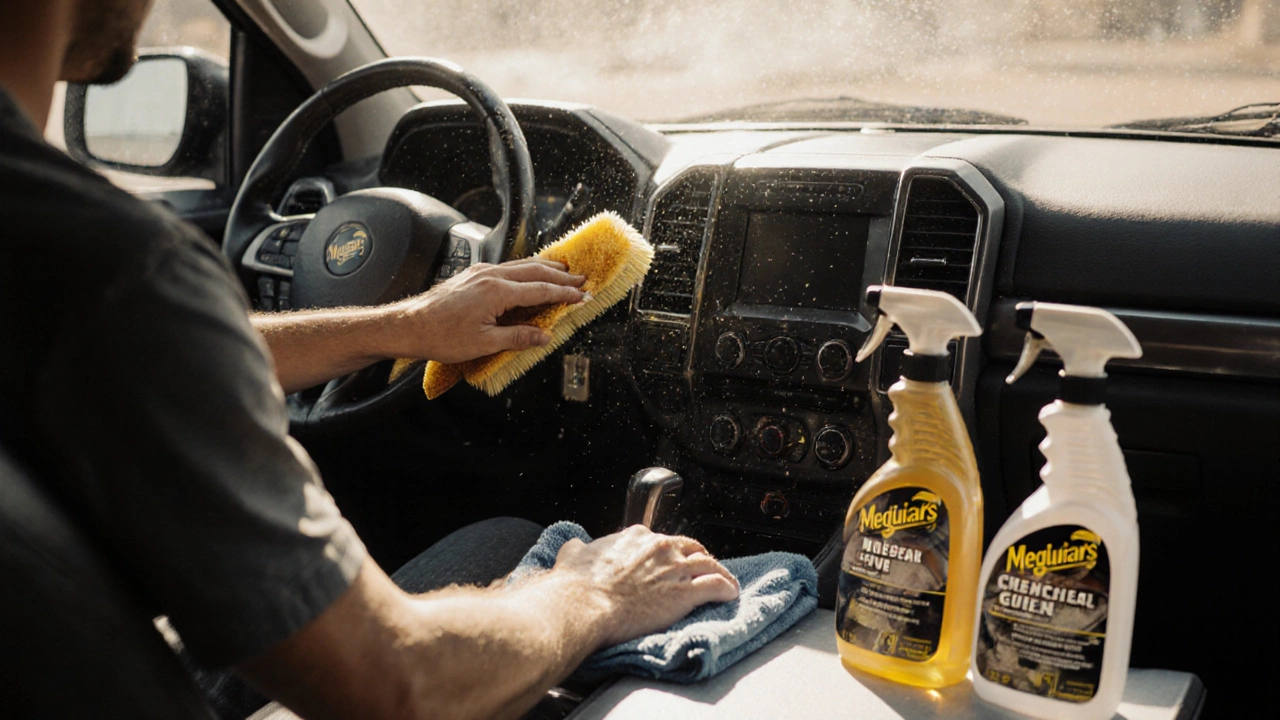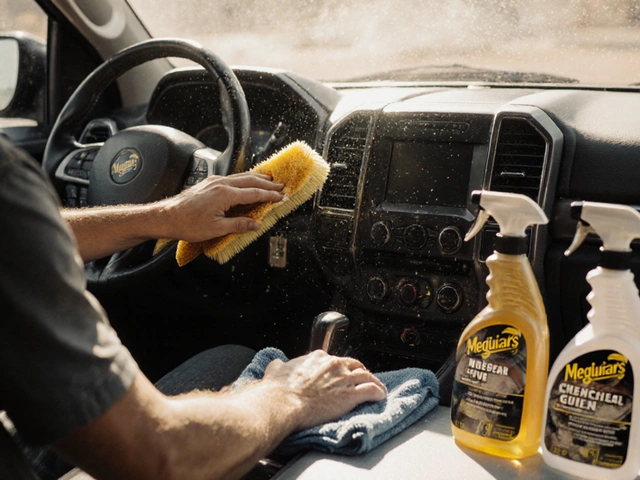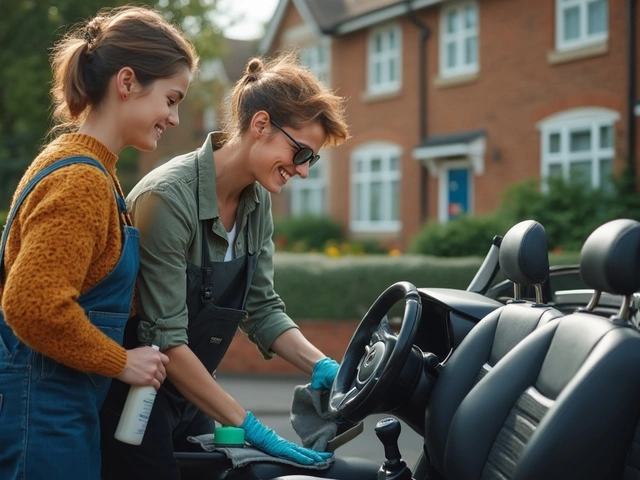Car Interior Restoration Assessment
Identify your car interior issues and get customized restoration recommendations. Select all problems you're experiencing, then click "Assess My Car" to see your personalized plan.
Your Car Interior Issues
Personalized Restoration Plan
Your car’s interior used to feel fresh. The seats weren’t stiff, the dashboard didn’t crack, and the carpets didn’t smell like old snacks and wet dog. Now? It looks like it’s been through a war. But here’s the truth: you don’t need to buy a new car to fix it. You just need the right steps - no magic sprays, no expensive shop visits.
Start with a Deep Clean - Not Just a Vacuum
Most people think cleaning the car interior means running a vacuum over the floor mats and calling it a day. That’s not cleaning. That’s dusting. Real cleaning starts with removing everything - floor mats, seat covers, trash, chargers, kids’ toys, that half-eaten energy bar from three months ago. Take out the center console tray. Pull the seats forward if you can. Get into every crevice.
Use a soft-bristle brush for vents, cup holders, and seams. A toothbrush works fine. Spray a mild interior cleaner - like Meguiar’s All-Purpose Cleaner or Chemical Guys InnerClean - onto the brush, not directly on the surface. Wipe with a microfiber cloth. Don’t soak anything. Water left in seams breeds mold and smells worse than before.
For carpets and floor mats, use a carpet extractor if you have one. If not, scrub with a stiff brush and a mix of warm water and a few drops of dish soap. Rinse with a damp cloth. Let them dry completely before putting them back. Wet carpets = mildew. Mildew = money down the drain.
Restore the Dashboard and Plastic Trim
That dull, sticky, cracked dashboard? It’s not broken. It’s just faded. UV rays and heat from the sun turn plastic brittle and gray. You can bring it back.
First, clean it with isopropyl alcohol (70% or higher). Dampen a microfiber cloth, wipe down the entire dash, center console, and door panels. This removes grease, sunscreen residue, and old protectants that block new ones from sticking.
Then, use a silicone-free trim restorer. Avoid the shiny, greasy sprays you see on TV. They attract dust and turn sticky within days. Instead, go for something like Chemical Guys VRP or Meguiar’s Ultimate Black. Apply with a foam applicator, let it sit for 2 minutes, then buff off with a clean cloth. It won’t look like new plastic - but it will look like new finished plastic. Dark, even, non-glossy. Realistic.
For cracked areas, use a trim repair pen. They’re cheap, under $10 on Amazon. Match the color, dab it on, let dry. It won’t fix structural damage, but it hides the worst of it.
Revive the Seats - Cloth or Leather
Leather seats dry out. Cloth seats stain. Both can be fixed.
For leather: Clean with a pH-balanced leather cleaner like Lexol. Don’t use saddle soap - it strips oils. After cleaning, apply a conditioner with UV protection. Apply thin layers. Let it soak in for 15 minutes, then wipe off excess. Do this twice a year. Your seats will feel supple again, not like plastic wrap.
For cloth: Start with a fabric cleaner like 303 Fabric Cleaner. Spray, scrub with a brush, blot with a towel. For stains - coffee, grease, ink - use a stain remover designed for automotive fabric. Don’t scrub too hard or you’ll fray the weave. For stubborn odors, sprinkle baking soda, leave it overnight, then vacuum. If the smell still lingers, try an ozone generator. They’re used by detailers to kill odor molecules at the source. You can rent one for $40 a day.
Replace Worn-Out Floor Mats
Old, stained, crumbling floor mats are the #1 thing that makes a car look old. No matter how clean the rest is, if the mats look like they’ve been dragged through a mud pit, the whole interior feels neglected.
Buy custom-fit rubber or all-weather mats. WeatherTech and Husky Liners are the two best brands. They’re molded to your exact model, have raised edges to trap dirt, and are easy to rinse off. They cost $80-$150, but they last 5+ years. Compare that to $30 fabric mats that fall apart in 12 months.
Pro tip: Spray the back of the mats with a non-slip rubber coating before installing. They won’t slide around when you brake hard.

Fix the Headliner - Yes, It’s Possible
The headliner is that fuzzy ceiling fabric above your head. Over time, it sags, stains, or peels. Most people think it’s a $500 repair job. It’s not.
If it’s just sagging in one spot, use a spray adhesive like 3M Super 77. Lift the fabric gently, spray a thin line along the edge where it’s detached, press it back into place. Hold for 30 seconds. Repeat. It holds for years.
If it’s stained or torn, you can buy a headliner repair kit. They come with pre-cut fabric patches and adhesive. It’s messy, but it’s cheaper than replacing the whole thing. And if you’re handy, you can remove the headliner yourself in under 2 hours with a screwdriver and a helper. YouTube has step-by-step videos for your exact car model.
Refresh the Air - And Keep It That Way
A car that smells bad will always feel old. Even if everything else looks perfect.
Replace the cabin air filter. It’s usually behind the glove box. You can get one for $15-$30. Do it every 12-18 months. It improves airflow and stops dust from circulating.
Use an odor eliminator, not an air freshener. Air fresheners cover smells. Eliminators destroy them. Try Ozium or a UV-C air purifier that plugs into the 12V socket. Run it for 30 minutes with the windows closed. Do this once a month.
Keep a small trash bag in the car. Empty it weekly. No food. No wrappers. No wet towels. That’s the biggest cause of bad smells.
Final Touches - Small Things, Big Impact
Here’s what most people forget:
- Replace the gear shift knob if it’s cracked or worn. A new one costs $15 and takes 5 minutes to install.
- Use a steering wheel cover if the leather is cracked. It protects your hands and hides damage.
- Wipe down the window switches and buttons with a damp cloth. Finger grease builds up and turns them sticky.
- Put a small dehumidifier pack under the passenger seat. It stops moisture from collecting in the footwell.
- Keep a microfiber cloth and a mini vacuum in the glove box. Wipe down surfaces after every long drive.
Do this every month - even if the car looks fine. Prevention is cheaper than repair.

What Not to Do
Don’t use olive oil on the dashboard. It looks shiny for a day, then turns sticky and attracts dust like a magnet.
Don’t use Windex on plastic or leather. It contains ammonia that dries out materials and cracks them over time.
Don’t buy cheap ‘miracle’ cleaners from discount stores. They’re full of silicones and solvents that damage surfaces long-term.
Don’t skip drying. Water left in seams, under seats, or behind trim leads to mold, rust, and that weird ‘wet dog’ smell that never goes away.
How Long Does It Take?
If you do it right, you can restore your car’s interior in a weekend. Two days. Four to six hours total. You don’t need a garage. A driveway and a hose are enough.
And here’s the kicker: if you do this once a year, your car will look new for 10+ years. Even if you drive 20,000 kilometers a year. Even if you have kids. Even if you live in Melbourne’s rainy season.
It’s not about money. It’s about consistency.
Can I use household cleaners on my car interior?
Some household cleaners can damage car interiors. Vinegar, Windex, and bleach are too harsh - they strip protective coatings and dry out plastic and leather. Mild dish soap diluted in water is safe for non-porous surfaces like the dashboard, but always test in a hidden spot first. Stick to products made for automotive interiors - they’re formulated to protect materials without causing long-term damage.
How often should I clean my car interior?
Do a quick wipe-down of surfaces once a week. Vacuum the floor and seats every two weeks. Do a deep clean - including seats, carpets, and trim restoration - every 3 to 6 months. If you drive daily, have kids, or eat in the car, do it every 3 months. If you only use the car on weekends, once every 6 months is fine.
Will detailing my car interior increase its resale value?
Yes, significantly. A well-maintained interior can add $1,000 to $3,000 to the resale value of a used car, depending on the model. Buyers notice cracked dashboards, stained seats, and musty smells immediately. A clean, fresh interior signals that the car was cared for - which makes them trust the rest of the vehicle more.
Is it worth buying a steam cleaner for car interiors?
Only if you have heavy stains or odors. Steam cleaners are great for deep-cleaning carpets and fabric seats, especially after spills or pet accidents. But they’re overkill for regular maintenance. For most people, a good fabric cleaner and a vacuum are enough. Steam can also damage electronics if you’re not careful - don’t point it at buttons, screens, or air vents.
Why does my dashboard keep getting sticky even after cleaning?
Sticky dashboards are usually caused by old silicone-based protectants that break down under UV light. When you clean with regular sprays, you’re just moving the residue around. The fix: clean with isopropyl alcohol first to strip away all old products. Then use a silicone-free, UV-protective trim restorer. Avoid glossy sprays - they’re the main culprit. Stick to matte or satin finishes for a natural, non-sticky look.
Next Steps
Start today. Take 20 minutes. Remove the floor mats. Vacuum under the seats. Wipe the dash with a damp microfiber cloth. That’s it. You’ve already begun.
Next weekend, tackle the seats. The week after, restore the trim. Do one thing at a time. Don’t wait for the perfect day. Your car won’t wait.
Within a month, you’ll notice the difference. Not just in how it looks - but how you feel when you get in. It’s not just a car anymore. It’s yours again.




